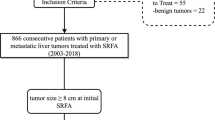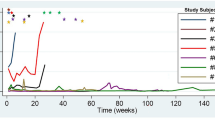Abstract
Background
Treatment options for patients with inoperable primary or recurrent/metastatic abdominopelvic malignancies are limited, and these patients have short lifespan. The purpose of our study is to examine outcomes of combined open radiofrequency ablation (RFA) and surgical debulking of otherwise unresectable tumors.
Methods
Consecutive 50 patients were identified from an Institutional Review Board (IRB)-approved database undergoing ablation for unresectable abdominopelvic malignancies via conventional surgical methods in a single institution between 07/2003 and 09/2009. Patients were selected for debulking if they had a dominant mass that caused significant symptoms.
Results
Sixteen patients had primary tumors, and 34 presented with a recurrent/metastatic malignancy. The primary tumors were abdominopelvic sarcomas (eight patients), large desmoids (two), colorectal cancer (CRC) (two), and gastric cancer, mucinous cystic pancreatic neoplasm, gastrointestinal stromal tumor (GIST), and carcinoid (one each). The recurrent/metastatic tumors were CRCs (16 patients), abdominopelvic sarcomas (12), and GIST, prostate cancer, bladder cancer, melanoma, adrenal cancer, and pseudomyxoma peritonei recurrences (1 each). Twenty-two patients were alive and 28 died as of September 2009. Median survival for patients who died was 9.5 months and for patients who were alive was 22 months. Patients with primary tumors had 5-year survival of 18% compared with no survivors at 5 years in the recurrent/metastatic group (P = 0.002).
Conclusions
Thermosurgical ablation of otherwise unresectable primary tumors and recurrent/metastatic abdominopelvic malignancies is feasible in selected cases. Patients with ablated primary tumors have a survival advantage over patients who have ablation for recurrent/metastatic disease.



Similar content being viewed by others
References
Ni Y, Mulier S, Miao Y, et al. A review of the general aspects of radiofrequency ablation. Abd Imaging. 2005;30:381–400.
Gillams AR. The use of radiofrequency in cancer. Br J Cancer. 2005;92:1825–9.
Fernando HC, Hoyos AD, Little V, et al. Radiofrequency ablation: identification of the ideal patient. Clin Lung Cancer. 2004;6:149–53.
Rhim H, Dodd GD III, Chintapalli KN, et al. Radiofrequency ablation of abdominal tumors: lessons learned from complications. Radiographics. 2004;24:41–52.
Poston GJ. Radiofrequency ablation of colorectal liver metastases: where are we really going? J Clin Oncol. 2005;23:1342–4.
Lefevre JH, Parc Y, Lewin M, et al. Radiofrequency ablation for recurrent rectal cancer. Colorectal Dis. 2008;10(8):781–4.
Pearlman NW, McCarter MD, Escobar G, et al. Combined radio-frequency-surgical debulking of advanced abdomino-pelvic tumors. Am J Surg. 2006;192:833–6.
Kaplan E, Meier P. Nonparametric estimation from incomplete observations. J Am Stat Assoc. 1958;53:457–81.
Elliott JA. Electrosurgery. Its use in dermatology with a review of its development and technical aspects. Arch Dermatol. 1966;94:340–50.
Reuter MA, Reuter HJ. The development of urologic endoscopy in America. World J Urol. 1999:17:176–83.
Cushing H. Electro-surgery as an aid to the removal of intracranial tumors. Surg Gynecol Obstet. 1928;47:751–84.
Strauss AA, Strauss SF, Crawford RA. Surgical diathermy of carcinoma of the rectum. Its clinical end results. JAMA. 1935;104:1480–4.
Buysse S, Valleylab, Tyco Health Care, Boulder, CO. Personal communication, August, 2005.
Lefevre JH, Lewin M, Bennis M, et al. Radiofrequency ablation for recurrent pelvic cancer. Colorectal Dis. 2007;10:781–4.
Machi J, Oishi AJ, Furumoto NL, Oishi RH. Sonographically guided radio-frequency thermal ablation for unresectable recurrent tumors in the retroperitoneum and the pelvis. J Ultrasound Med. 2003;22:507–13.
Campos FG, Habr-Gama A, Kiss DR, et al. Management of the pelvic recurrence of rectal cancer with radiofrequency thermoablation: a case report and review of the literature. Int J Colorectal Dis. 2005;20:62–6.
Spiliotis J, Hadjicostas P, Rogdakis A, et al. Management of advanced abdomino-pelvic tumors with combined radiofrequency ablation and surgical debulking. Dig Surg. 2008;25:188–90.
Author information
Authors and Affiliations
Corresponding author
Rights and permissions
About this article
Cite this article
Gajdos, C., MacDermott, T., McCarter, M.D. et al. Combined Thermal–Surgical Ablation of Locally Advanced Abdominopelvic Malignancies. Ann Surg Oncol 18, 1267–1273 (2011). https://doi.org/10.1245/s10434-010-1467-4
Received:
Published:
Issue Date:
DOI: https://doi.org/10.1245/s10434-010-1467-4




